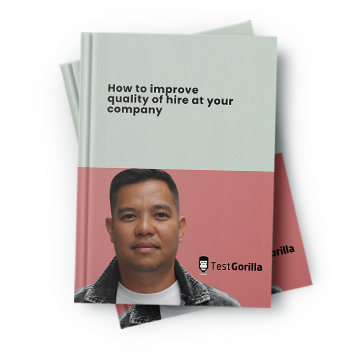Best practices for setting up asynchronous video interviews
Science series materials are brought to you by TestGorilla’s Assessment Team: A group of IO psychology, data science, psychometric experts, and assessment development specialists with a deep understanding of the science behind skills-based hiring.
Over the years, organizations have introduced various technologies to their recruitment and personnel selection processes in an effort to enhance efficiency, reduce costs, and improve the likelihood of a successful hire.
As one of the most widely utilized hiring tools, interviews provide ample room for innovation. Asynchronous or one-way video interviews represent the latest evolution in the approach and have become an increasingly popular alternative to video conferencing or in-person interviews.
Table of contents
What is an asynchronous video interview?
In an asynchronous video interview, candidates are given a structured series of interview questions. They are usually given a set amount of time for each response and are allowed a limited number of attempts at every question. Job applicants record answers to these questions on a camera and submit them via an online portal.
Each candidate’s interview is evaluated against pre-defined criteria to determine their suitability for the role.
4 benefits of asynchronous video interviews
One-way interviews offer many advantages over the traditional model of two-way interviews.
1. Streamlining and standardizing the hiring process
Asynchronous video interviews minimize many of the inefficiencies present in traditional in-person interviews.
The standardized nature of these sessions means that all questions relate directly to the core competencies of the role, with little room for vague, open-ended queries, which are more difficult to assess objectively.
Additionally, interviewees are given the same amount of time to respond to each question, so their answers can be compared on a like-for-like basis.
Video response questions can be a powerful tool for skills-based hiring. You can screen candidates quickly for skills such as foreign language proficiency and interpersonal communication without conducting a lengthy interview process.
2. Reducing logistical hurdles
In-person and two-way video interviews present considerable logistical challenges for employers and job applicants. HR teams must coordinate with candidates to identify an appropriate time for the meeting, while applicants must ensure they have full availability during this period. In some cases, the candidate may need to make travel arrangements for the interview.
By contrast, asynchronous video interviews can be conducted anytime and in any environment according to the candidate’s preferences. This added flexibility contributes to a better candidate experience, ensuring that applicants who may otherwise be forced to drop out of a hiring process have the chance to participate on equal footing with others.
3. Scalability
Asynchronous video interviews can be distributed instantly to a global applicant pool. Video segments are collected directly via online platforms and are accessible on-demand to relevant hiring managers and other stakeholders across the organization.
These advantages make one-way interviews particularly well-suited to high-volume hiring situations where hundreds or even thousands of candidates need to be screened.
4. Effectively predicting job performance
Research shows that even brief “slices” of verbal and nonverbal interaction, such as those captured in a video response question, can at least partially predict the outcome of a whole interview. Prior research on the topic also indicates that objective reviewers can make accurate judgments on the personality traits or characteristics of complete strangers based on short video segments.
In terms of performance, various studies suggest that candidates perform better during asynchronous video interviews compared to face-to-face meetings. One possible reason for this discrepancy is the added preparation time afforded by one-way interviews. Candidates also have more time to prepare and organize their responses when answering interview questions.
How to improve your candidates’ video response experience
One-way interviews and video response questions still have their critics, and one of their main drawbacks is the impersonal nature of asynchronous, asymmetrical interaction. Luckily, new research published in the International Journal of Selection and Assessment gives us insight into how to make the video response format feel more personalized.
Ask your questions via video
According to the work of Rizi and Roulin (2023), asking your candidates questions via video recording rather than by plain text produces multiple benefits. Though the interaction remains asynchronous and all the advantages of a one-way interview are retained, the feeling of detachment experienced by a candidate recording an answer for some faceless hiring manager is lessened when they can see the person on the other side of the interview.
If you record yourself asking the questions rather than typing them out, you are helping to put the human element back in the hiring process. This helps in a number of ways.
Increased feeling of “social presence”
Social presence describes the candidate’s sense of the interviewer’s “realness” within the interview process. It refers to the feeling of connection and interactivity that the interviewer and interviewee experience.
By recording a video of the interviewer asking a question rather than presenting the question by text, you can give candidates a greater sense of the social presence of their interviewer, thus making the interview feel more connected, social, and personal.
Decreased candidate anxiety
Using video recordings to ask interview questions also results in a decrease in candidate interview anxiety when compared to text-based prompts. Not only does this make for a more pleasant candidate experience, but it could also have an impact on your ability to find the right talent by not missing out on “anxious interviewees.”
Interview anxiety can hinder candidates' interview performance and harm their chances of getting hired. However, interview anxiety cannot be used to predict a candidate’s ultimate job performance. Therefore, anxiety during the interview may prevent some of your best candidates from getting hired. Introducing your video response questions with videos of your own may help reduce this risk.
Improved interview performance
In their study, Rimi and Roulin found that candidates who received video introductions and video questions to answer via a video message performed significantly better in their one-way interviews than the candidates who only received textual information.
The production value of the video messaging did not impact candidate performance. Candidates performed just as well when the introductory video material was filmed on a cellphone by the interviewer themselves as when the video was recorded on a professional camera and included official corporate content.
Set yourself apart with TestGorilla’s Video Response Questions
Despite the evidence for the value of video-recorded questions for one-way interviews, most companies haven’t caught on. More than 95% of employers using asynchronous video interviews introduce their questions via text.
Set your company apart by recording a video to introduce your own custom video questions to decrease your candidates’ anxiety, increase their sense of trust and social presence in your company, and boost their overall interview performance. You can record these questions with nothing more than a cellphone camera or a webcam—no expensive AV equipment is required.
To further increase your company’s social presence for your candidates, consider using TestGorilla’s welcome video functionality, available to users on Starter and Pro plans.
When you use TestGorilla’s one-way interview software, remember interview best practices, both when recording your questions and evaluating your candidates.
Structured interviews can help reduce cost-per-hire, time-to-hire, and bias in the hiring process. They give you data you can use to make your hiring decisions, and they give candidates the ability to showcase their skills, not just their past experiences. Research has supported the role of structured interviews in improving hiring decisions and mitigating the potential negative effects of cultural differences between interviewer and candidate.
One-way video interviews are an increasingly important tool for recruiters, and setting them up properly will create a better experience and a more positive brand impression for your candidates. They represent an opportunity for your candidates to speak for themselves–and if used correctly, they give you the same opportunity.
With TestGorilla, you can add asynchronous video questions with video introductions as part of your pre-employment skills testing assessment. Try it for free today or read more about the science behind TestGorilla.
Sources
Rizi, M. S., & Roulin, N. (2023). Does media richness influence job applicants' experience in asynchronous video interviews? Examining social presence, impression management, anxiety, and performance. International Journal of Selection and Assessment.
Dunlop, P. D., Holtrop, D., & Wee, S. (2022). How asynchronous video interviews are used in practice: A study of an Australian‐based AVI vendor. International Journal of Selection and Assessment, 30(3), 448-455.
Powell, D. M., Stanley, D. J., & Brown, K. N. (2018). Meta-analysis of the relation between interview anxiety and interview performance. Canadian Journal of Behavioural Science/Revue canadienne des sciences du comportement, 50(4), 195.
Schneider, L., Powell, D. M., & Bonaccio, S. (2019). Does interview anxiety predict job performance and does it influence the predictive validity of interviews?. International Journal of Selection and Assessment, 27(4), 328-336.
Levashina, J., Hartwell, C. J., Morgeson, F. P., & Campion, M. A. (2014). The structured employment interview: Narrative and quantitative review of the research literature. Personnel Psychology, 67(1), 241-293.
McCarthy, J. M., Van Iddekinge, C. H., & Campion, M. A. (2010). Are highly structured job interviews resistant to demographic similarity effects?. Personnel Psychology, 63(2), 325-359.
Related posts
Hire the best candidates with TestGorilla.
Create pre-employment assessments in minutes to screen candidates, save time, and hire the best talent.
Latest posts
The best advice in pre-employment testing, in your inbox.
No spam. Unsubscribe at any time.

Hire the best. No bias. No stress.
Our screening tests identify the best candidates and make your hiring decisions faster, easier, and bias-free.
Free resources
Anti-cheating checklist
This checklist covers key features you should look for when choosing a skills testing platform
Onboarding checklist
This resource will help you develop an onboarding checklist for new hires.
How to find candidates with strong attention to detail
How to assess your candidates' attention to detail.
How to get HR certified
Learn how to get human resources certified through HRCI or SHRM.
Improve quality of hire
Learn how you can improve the level of talent at your company.
Case study: How CapitalT reduces hiring bias
Learn how CapitalT reduced hiring bias with online skills assessments.
Resume screening guide
Learn how to make the resume process more efficient and more effective.
Important recruitment metrics
Improve your hiring strategy with these 7 critical recruitment metrics.
Case study: How Sukhi reduces shortlisting time
Learn how Sukhi decreased time spent reviewing resumes by 83%!
12 pre-employment testing hacks
Hire more efficiently with these hacks that 99% of recruiters aren't using.
The benefits of diversity
Make a business case for diversity and inclusion initiatives with this data.

























